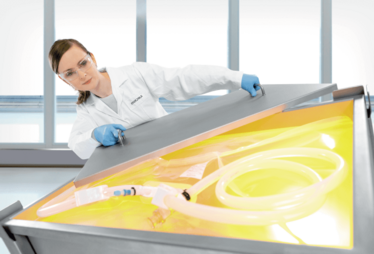
Success at Speed: Digging into Accelerated Vaccine Development
Part 6 – logistics and global availability. A vaccine must be able to reach patients who need it. Reliable partners and procedures are a must.
Piergiuseppe Nestola, Amélie Boulais |
sponsored by Sartorius
The sensitive nature of vaccines, coupled with the fact that some countries may not have reliable infrastructure, can make distribution challenging. Environmental conditions across the supply chain can degrade potency. To offer some well known examples, heat-sensitive vaccines include the oral polio vaccine (OPV) and measles, mumps and rubella (MMR); those sensitive to freezing include hepatitis B, human papillomavirus (HPV), and influenza. Other vaccines are sensitive to light, such as Bacillus Calmette–Guérin (BCG) for tuberculosis, and MMR.
Generally speaking, live vaccines (bacterial or viral) are particularly prone to potency loss through higher temperatures, and their stability is often comprised already at room temperature. Whereas, non-live vaccines (inactivated, proteins) are more stable in higher temperatures, but are often more sensitive to freezing because they contain adjuvants (salt aluminium, for example, can collapse during freezing).
The unique characteristics of the vaccine platform and formulation will determine the required storage conditions, and the resulting range of optimal temperatures is significant. Some vaccines must be stored at around 2–8 °C, whereas others require temperatures as low as -80 °C (particularly challenging to maintain during distribution). Clearly, improving the thermostability of a given vaccine can pay dividends when it comes to later logistics and cold chain management. Some “new generation” vaccines behave differently to the classic vaccines noted above and can be much less sensitive to environmental conditions (1). Thus, combined with advances in formulation development, it is now possible to create vaccines that are stable even at room temperature. Recent research has also indicated that certain mRNA formulations maintain stability at room temperature (2).

Whatever the vaccine, any transportation method must be validated and carefully monitored as part of the global GMP requirement to validate the drug process. ASTM and ISTA offer standard guidelines for shipment testing and the WHO recommends electronic monitoring. Notably, you should not only consider the shipping method for your final drug product, but also any transport required for the drug substance; for example, to a separate fill/finish facility. Accidental rupture of bags or container breakage can occur, and so it is crucial to ensure that any shipping materials are able to withstand the various forces that may occur along the journey. For the same reason, it’s important to use reliable (and knowledgeable) shipping partners. Ultimately it is a combination of material, experienced partners and digital monitoring that can ensure that the quality of the drugs is preserved during shipments, and that the drugs keep their potency when delivered to the patients.
When addressing security risk for drug distribution, additional factors have to be taken into account: counterfeit drugs and stolen material. The pressure to get vaccines may attract the lust of people trying to make money with fraudulent drugs. Serialization is a good answer for better controlling the drug supply. The choice of reliable transportation partners is a must to avoid thefts of drugs during their distribution journey.
Vaccine production has historically been centralized by a few key manufacturers, but the trend is shifting. After all, centralized manufacturing can be risky; if there is a problem at the main plant, disruption of global distribution of the vaccine ensues. Looking to better guarantee availability of routine vaccines, such as diphtheria, pertussis and tetanus (DTP), MMR, polio, and influenza, governments around the world have been actively funding local manufacturing capacity, which will certainly have an impact on logistics. COVID-19 has made the threat of disruption even more real – and it has also introduced additional challenges. Companies are already taking orders from governments for vaccines that are still in development. Assuming success, there will ultimately (and suddenly) be a high request for rapid vaccine shipments. In this regard, diversified supply chains and localized production will likely offer significant benefits.
Find out more: http://ow.ly/6wpi50AFT0x
- U Kartoglu, J Milstien, “Tools and approaches to ensure quality of vaccines throughout the cold chain,” Expert Review of Vaccines, 13 (2007).
- C Zhang et al., “Advances in mRNA Vaccines for Infectious Diseases,” Front. Immunol., (2019).
Head of Market Entry Strategy, Virus Based Therapeutics at Sartorius.



















